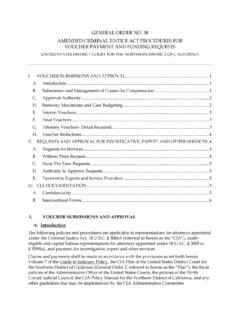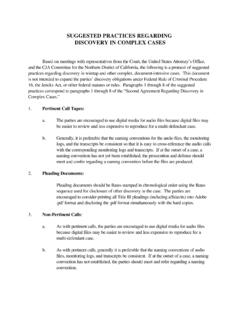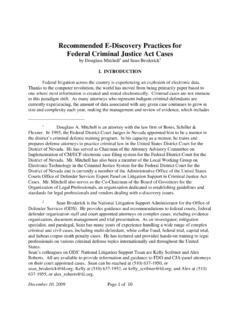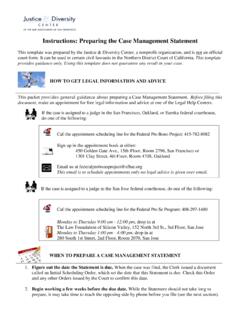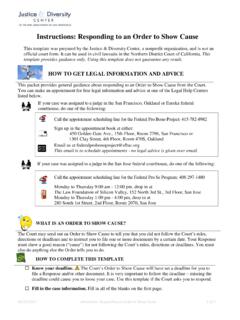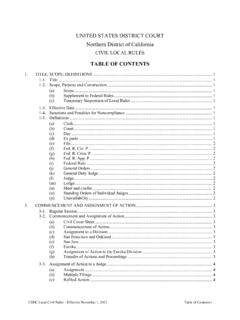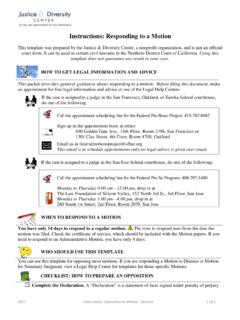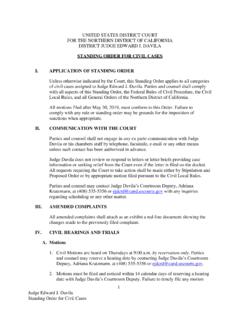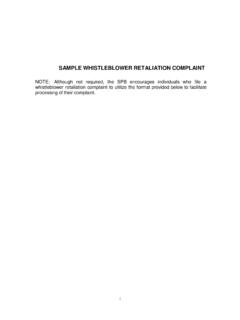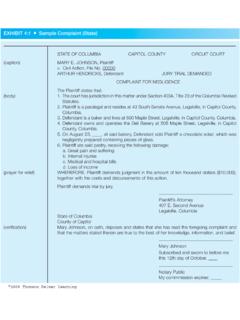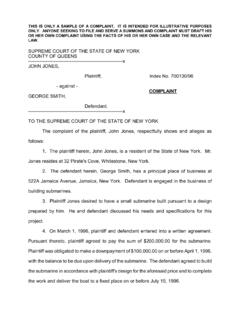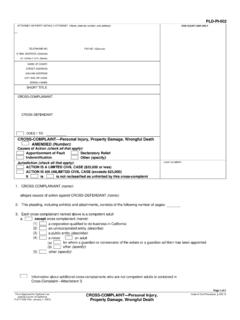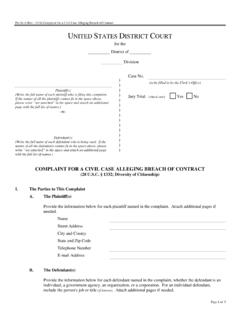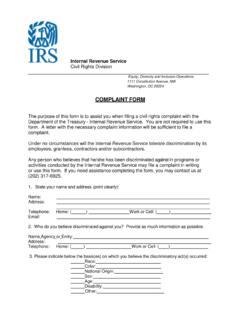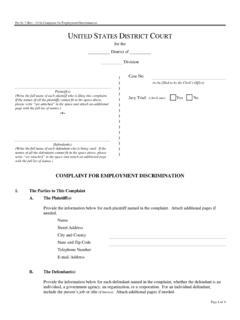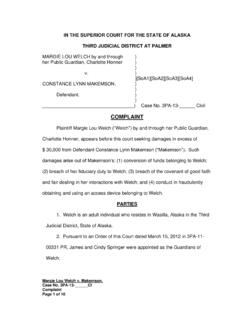Transcription of Instructions: Answer - Responding to the Complaint
1 Instructions: Answer - Responding to the Complaint The Answer template in this packet was prepared by the Justice & Diversity Center, a nonprofit organization, and is not an official court form. It can be used in certain civil lawsuits in the Northern District Court of California. This template provides guidance only. Using this template does not guarantee any result in your case. HOW TO GET LEGAL INFORMATION AND ADVICE. This packet provides general guidance and does not tell you everything you need to know about Responding to a Complaint . You can make an appointment for free legal information and advice at one of the Legal Help Centers listed below. If the case was assigned to a judge in the San Francisco, Oakland or Eureka federal courthouse, do one of the following: Call the appointment scheduling line for the Federal Pro Bono Project: 415-782-8982. Sign up in the appointment book at either: 450 Golden Gate Ave., 15th Floor, Room 2796, San Francisco or 1301 Clay Street, 4th Floor, Room 470S, Oakland Email us at This email is to schedule appointments only - no legal advice is given over email.
2 If the case was assigned to a judge in the San Jose federal courthouse, do one of the following: Call the appointment scheduling line for the Federal Pro Se Program: 408-297-1480. Monday to Thursday 9:00 am - 12:00 pm, drop in at The Law Foundation of Silicon Valley, 152 North 3rd St., 3rd Floor, San Jose Monday to Thursday 1:00 pm - 4:00 pm, drop in at 280 South 1st Street, 2nd Floor, Room 2070, San Jose 1 of 6. 2017. DECIDE HOW TO RESPOND TO THE Complaint . Most Defendants file an Answer to the Complaint . If the Plaintiff did not follow the rules when serving you with the Complaint , the Complaint is missing certain information, or the Complaint shows that the Plaintiff cannot win, it may be possible to file a Motion to Dismiss the Complaint instead. If you are considering filing a Motion to Dismiss, contact one of the Legal Help Centers (see page 1). You have limited time to file a response to the Complaint . HOW TO COMPLETE THIS Answer TEMPLATE.
3 1. Know your deadline. You have only 21 days after being served with the Summons and Complaint to file a response. If you need additional time, or have missed the deadline, it is normally best to contact the opposing side's lawyer right away and make arrangements. The Legal Help Centers (see page 1) can explain the process. 2. Fill in the case information. On the top of the first page, write your name and address. Check the box for the division to which your case has been assigned. Write in the plaintiff's and defendant's names in the middle of the front page. Then, to the right of the names, fill in the case number and write in the judge's name. 3. Respond to each paragraph in the Complaint . Read each sentence of the Complaint . Each paragraph should be numbered. If everything in the paragraph is false, do not write that paragraph number anywhere. The first part of this Answer denies everything unless you actually admit to it. If everything in the paragraph is true, write that paragraph number in Section B of this Answer form.
4 If you don't know whether the paragraph is true or not, write that paragraph number in Section C. If the paragraph is partly true and partly false, write that paragraph number in Section D and explain which specific parts of the paragraph are true. For example: 1. Responses to the Claims in the Complaint A. Defendant denies each and every allegation in the Complaint except those specifically admitted in this Answer . B. Defendant admits all of the allegations in the following paragraphs: 1, 3, 4, 10, 12. C. Defendant does not know or have enough information to form a belief 2 of 6. 2017. as to whether the allegations in the following paragraphs are true: 5, 6, 7, 13, 14, 15, 16. D. Defendant admits only the following parts of each paragraph listed below, and denies or does not know enough to say whether the rest of the paragraph is true: Paragraph 2 : I admit only that I am a citizen of the state of California. Paragraph 11 : I admit only that I visited the Plaintiff at his house on May 3, 2014.
5 4. List your defenses. An affirmative defense is an argument that Plaintiff's claim should fail for some procedural or legal reason. The purpose of an affirmative defense is to give enough notice of your defenses so that Plaintiff and the Court understand your argument. In Section 2 of your Answer , include all affirmative defenses that you may have. If you leave something out, the Court may not let you argue that the defense applies later in the case. If you don't know the right legal terms for your defenses, just explain your reasons clearly in your own words. If you are not sure about your defenses, contact the Legal Help Center (see page 1). Example 1: Statute of Limitations Plaintiff sued Defendant in 2010 for stealing his expensive sports car. The car was stolen in 1990 and Plaintiff has known about the theft since then. California has a three-year statute of limitations on lawsuits alleging theft of personal property, so Plaintiff only had until 1993 (three years after the theft) to file his lawsuit.
6 In his Answer , Defendant will explain that Plaintiff's lawsuit should be dismissed because the statute of limitations has expired. Example 2: Assumption of the Risk Defendant teaches surfing lessons. Before allowing Plaintiff to become a student, Defendant required Plaintiff to sign an agreement that stated, I understand that surfing is a dangerous activity and I voluntarily and knowingly assume the risk of injury during these surfing lessons. During a lesson, a big wave caused Plaintiff to hit his head on his surfboard. Plaintiff sued Defendant for his injury. In his Answer , Defendant will explain that Plaintiff's lawsuit should be dismissed because Plaintiff assumed the risk of injury. In other words, Plaintiff knew the risks and took the lessons anyway. 5. OPTIONAL: Write your own claims. Although it is not common, sometimes defendants bring their own claims against the plaintiff or another person in response to a lawsuit. If your claims are related to same events or facts as those stated in the Complaint , then you must include them in your Answer or you could lose your right to make those claims in the future.
7 A Counterclaim is a Complaint by the defendant against the plaintiff. A Crossclaim is a Complaint by one defendant against another defendant, or against someone who is not yet part of the lawsuit. For example, you may file a crossclaim if another person caused some of the injuries for which Plaintiff is suing you. If you want to make a Counterclaim or Crossclaim, be sure to check the box for Counterclaim or Crossclaim on the first page of the Answer . Next, in the Counterclaim or Crossclaim section, identify who you are suing. Then, write in the type of claim you have or the law that was violated. Starting with Paragraph 3, write in the facts supporting your claim. Put each fact into a separate, 3 of 6. 2017. numbered paragraph. It is usually best to write the facts in the order that they happened. Start with the earliest time and continue until the most recent event. If you are not sure about whether to make a claim in your Answer , contact the Legal Help Center (see page 1).
8 6. Identify your demands. a. Complete the Demand for Relief section on the signature page. If you would like the Court to do something for you that is not listed, write that in. b. If you would like to request a jury trial at the end of your case, check the box in the Demand for Jury Trial section on the last page, and on the first page. Not all claims can be tried before a jury. 7. Number the pages. Remove any pages that you are not using, such as the Counterclaim or Crossclaim pages. Then, count the number of pages in your final Answer . In the bottom corner of each page, write in the page number and the total. 8. Review and sign your Answer . Read your Answer , making sure all blanks are filled in, and to confirm that all of the statements are true. Each defendant submitting the Answer must sign it. 9. Prepare the Certificate of Service. Each document that you file must be served on each other party. This is usually done by sending it in the mail.
9 A Certificate of Service is a paper that lets the Court know that you served the document listed on it. To prepare the Certificate, follow the instructions on it to complete each part, 1-7. CHECKLIST: FILING AND SERVING YOUR Answer . Make three copies. Once you have completely filled out and signed your Answer and Certificate of Service, make three copies of each document. On one copy of the documents, write Chambers on the top in pen. (If there is more than one plaintiff or defendant, you will also need one copy for each of them.). Serve the Answer . Be sure that the Answer and Certificate are served on each party. File the Answer . Deliver or mail the original plus two copies of the Answer and Certificate of Service to the Clerk's Office at the federal courthouse where the Judge for your case is located. The Clerk will take the original and one copy. The other copy is for you to keep after it is stamped by the Clerk. If you file by mail, include a self-addressed, stamped envelope so that the Clerk can send a copy back to you.
10 STAY UP TO DATE. 1. Tell the Court if you move. You must file a notice with the Clerk right away if your mailing address, phone number, or email address changes, or you may miss important deadlines, causing you to lose your case. 2. Check your mail. Be sure to check your mail regularly for documents from the Court or the opposing side. 4 of 6. 2017. 3. A list of all of the documents that have been filed, and (usually) the documents themselves can be viewed online. See Chapter 7 of the Handbook for Pro Se Litigants, and contact the Legal Help Center for information about how to access the documents (see page 1). TIMELINE: FIRST STEPS IN A CIVIL CASE. This timeline lists the first few things that happen in a civil case. The Legal Help Centers (see page 1) can provide guidance about these steps, and have many additional templates for documents you may need to file during this time and throughout your case. Both sides attend a Case Case begins when the Management Conference with Complaint is filed the judge and get the schedule Defendant is served with the for the rest of the case Complaint , Summons, and (usually within 90 days of the other documents case being filed).
